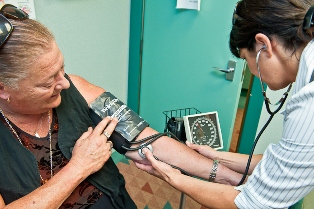This atlas domain was last updated in 2012.
Cardiovascular Indicators

The Cardiovascular Disease (CVD) management domain has been developed by the School of Population Health at the University of Auckland and is part of a larger project called the Health Research Council VIEW (Vascular Informatics using Epidemiology and the Web) programme.
Current New Zealand guidelines recommend that, unless contraindicated, people who have experienced an ischaemic CVD event (primarily heart attacks or stroke) should be treated with a combination of medications (also known as triple therapy) that includes aspirin (an antiplatelet agent), a statin and a blood pressure lowering drug.[1] There is a strong evidence base that each of these medications could reduce five-year event rates by 25-30 percent and triple therapy by at least 50 percent.[2-12] However, as with all medications there are potential risks and side effects and there will be some patients for whom these outweigh the benefits. We would not necessarily expect 100 percent of the at risk population to be on triple therapy.
The CVD management domain examined the use of secondary prevention medications in all New Zealand residents who were hospitalised with an ischaemic CVD event (myocardial infarction, ischaemic stroke and/or coronary or peripheral arterial procedure) between 2000 and 2010. A person was considered to be taking a medication consistently if they had been dispensed the following medications in at least three of the four quarters of 2011:
- A statin
- A blood pressure lowering drug
- An antiplatelet or anticoagulant drug
- Both a statin and a blood pressure lowering drug
- Triple therapy
Five important areas of variation were identified:
- Lower dispensing of statins: of the three types of secondary prevention medications, fewer CVD patients received statins compared to blood pressure lowering and antiplatelet/anticoagulant drugs.
- Age differences in medication dispensing: younger patients were far less likely than their older counterparts to be dispensed secondary preventive medication.
- Gender differences in medication dispensing: fewer women were dispensed statins and, to a lesser extent, antiplatelets/anticoagulants, compared to men.
- Ethnic differences in medication dispensing: Indians were approximately 10 percent more likely to be dispensed triple therapy than other ethnic groups, once age, gender, deprivation and region were adjusted for. There were no other significant differences between ethnic groups.
- Socioeconomic differences in medication dispensing: There were no apparent socioeconomic differences in the dispensing of CVD treatment
These indicators are based on pharmaceutical dispensing data, so a low result could mean a medication was not prescribed to a patient, that the patient did not fill their prescription for other reasons, or a combination of both of these reasons. It is assumed that if a patient is dispensed a medication, they are consuming it as prescribed by their health professional.
These findings stimulate questions such as what are the drivers for this variation? Should more patients be on secondary preventive therapy or does this variation represent correct interpretation of the evidence?
References
- New Zealand Guidelines Group. The assessment and management of cardiovascular disease. Wellington: New Zealand Guidelines Group; 2003.
- Afilalo J, Duque G, Steele R, et al. Statins for secondary prevention in elderly patients: a hierarchical Bayesian meta-analysis. J Am Coll Cardiol 2008;51:37-45.
- Henyan NN, Riche DM, East HE, Gann PN. Impact of statins on risk of stroke: a meta-analysis. Ann Pharmacotherapy 2007; 41:1937-45.
- LaRosa JC, He J, Vupputuri S. Effect of statins on risk of coronary disease. A meta-analysis of randomised controlled trials. JAMA 1999;282:2340-46.
- Law MR, Wald NJ, Rudnicka AR. Quantifying effect of statins on low density lipoprotein cholesterol, ischaemic heart disease, and stroke: systematic review and meta-analysis. BMJ 2003;326:1423.
- Pharoah PD, Hollingworth W. Cost effectiveness of lowering cholesterol concentration with statins in patients with and without pre-existing coronary heart disease: life table method applied to health authority population. BMJ 1996;312:1443-48.
- Gueyffier F, Boutitie F, Boissel J, et al. Effect of antihypertensive drug treatment on cardiovascular outcomes in women and men. A meta-analysis of individual patient data from randomised, controlled trials. Ann Intern Med 1997;126:761-67.
- Gueyffier F, Froment A, Gouton M. New meta-analysis of treatment trials of hypertension: improving the estimate of therapeutic benefit. J Hum Hypertension 1996;10:1-8.
- Howes LG, Lykos D, Rennie GC. Effects of antihypertensive drugs on coronary artery disease risk: a meta-analysis. Clin Exp Pharmacol Physiol 1996;23:555-58.
- Antithrombotic Triallists Collaboration. Aspirin in the primary and secondary prevention of vascular disease: collaborative meta-analysis of individual participant data from randomised trials. Lancet 2009;373:1849-60.
- Hart RG, Pearce LA, Aguilar MI. Meta-analysis: antithrombotic therapy to prevent stroke in patients who have nonvalvular atrial fibrillation. Ann Intern Med 2007; 146:857-67.
- Lip GYH, Edwards SJ. Stroke prevention with aspirin, warfarin and ximelagatran in patients with non-valvular atrial fibrillation: a systematic review and meta-analysis. Thrombosis Research 2006;118:321-33.
